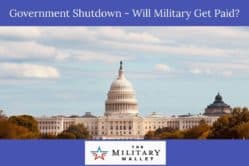Are you receiving all of the veterans’ benefits you’re eligible for?
There’s a good chance you aren’t.
The Veterans Pension Benefit with Aid and Attendance Allowance is a little-known and little-used benefit.
If a veteran (or surviving spouse) needs assistance with daily activities such as bathing, eating, general mobility, and more, this benefit can provide monthly compensation for just that.
The funds can be used for in-home care, assisted living, and nursing home care.
Only about 543,000 individuals currently receive the Veteran’s Pension Benefit/Aid and Attendance Allowance. That means less than 5% of those who may be eligible for the benefit are taking advantage.
Who is Eligible for the Veteran’s Pension Benefit?
The Veterans Pension program is a monthly payment to qualifying veterans who meet certain service criteria, age or disability requirements, and who have income and net worth within certain limits.
Servicemembers cannot receive both the Pension Benefit and VA Service-connected Disability Compensation at the same time. So veterans who are also eligible for disability compensation will need to run the numbers to determine which benefit is more valuable for their situation.
The Veterans Pension Benefit is available to active-duty veterans who meet the following requirements:
- Military Service Requirements –
- Those who joined active duty before September 8, 1980 – Served at least 90 days, with at least one of those days occurring during a period of war.
- Those who joined active duty after September 7, 1980 – Served at least 24 months, with at least one of those days occurring during a period of war.
- Combat service is not required, only that the veteran was in the service during wartime and received an honorable discharge.
- At least 65 years-old OR if younger than 65, have a permanent and total disability. Those who are patient in a nursing home for long-term care because of a disability, or are receiving Social Security Disability Insurance or Supplemental Security Income may also be eligible.
You should be able to prove your service during a time of war via your DD Form 214 or other military service records.
Here are the periods of war, as determined by the VA:
| Period or War | Beginning and Ending Dates |
| World War II | December 7, 1941, through December 31, 1946 |
| Korean Conflict | June 27, 1950, through January 31, 1955 |
| Vietnam Era | August 5, 1964, through May 7, 1975; for veterans who served “in country” before August 5, 1964, February 28, 1961, through May 7, 1975 |
| Gulf War | August 2, 1990, through a date to be set by law or Presidential Proclamation |
Who is Eligible for the Aid & Attendance Benefit?
Note: The Aid and Attendance benefit is a subset of the Veterans Pension benefit. “Aid and attendance” is a medical rating used by the VA. This means the VA acknowledges the veteran or surviving spouse needs the regular aid and attendance of another person.
In addition to meeting age and service requirements, in order to receive the Veteran’s Pension Benefit with Aid and Attendance Allowance, a veteran must demonstrate both financial and medical need.
This is determined based on an income and asset test, as well as a medical needs test.
If a Veteran’s Pension Benefit Applicant called a regional VA Benefits office to apply for benefits, the first thing the Veterans Service Representative would usually ask for is the total household income, the amount of assets the veteran owns, and his or her medical status.
Income Test
The veteran’s household income cannot exceed the Maximum Allowable Pension Rate (MAPR) for that application category. There are several categories of pension incomes, so determining eligibility can be complicated.
In addition, under certain circumstances, a veteran’s income can exceed the MAPR, provided there are enough non-reimbursable medical expenses or educational expenses to reduce the household income below the threshold.
Finally, on October 18, 2018, the VA changed the way they assess net worth to make the pension entitlement rules clearer. Net worth includes your and your spouse’s assets and annual income. When you apply for Veterans Pension benefits, you’ll need to report all of these assets and income.
For example, if you had $121,000 in assets and $14,000 in annual income, then your net worth would be $135,000. This is less than the 2024 net worth limit of $155,356. So you would be eligible for Veterans Pension benefits.
Countable income for a veteran or surviving spouse includes:
- Wages
- Pension payments
- Social security
- Retirement distributions
Non-reimbursable medical expenses can include:
- Health insurance premiums
- Prescription medications
- Necessary medical equipment (wheelchairs, walkers, hearing aids, etc.)
Example 1: A veteran and spouse apply for the Veteran’s Pension Benefit. They do not have a medical rating, and their combined income cannot exceed $1,500 a month or $18,008 a year from all sources. However, their income can be reduced by non-reimbursed medical expenses to fall under the $1,500/mo threshold. Some examples of qualifying non-reimbursed medical expenses include medical insurance such as Medicare Part B ($144.60 a month in 2020) and certain medical expenses associated with assisted living care or home care costs.
Example 2: Let’s assume the same veteran and spouse have difficulty performing daily activities and are applying for the Veteran’s Pension Benefit with Aid and Attendance Allowance. Their combined income cannot exceed $2,266 a month or $27,195 a year.
In both cases, the couple can deduct qualified medical expenses above 5% of their MAPR.
As you can see, the rules for income requirements can be quite complicated, but it can pay to investigate your eligibility.
Asset Test
As of 2024, a veteran applying for the Aid and Attendance Allowance cannot own cash assets of more than $155,356. This limit is updated each year on December 1st with a COLA increase matching the CPI used for Social Security.
Counting Assets:
In the case of this benefit, assets include:
- Checking and savings accounts
- Stocks, bonds, and mutual funds
- Vacation homes
The following are exempt from the asset test:
- Primary residence
- Automobiles for personal use
- Personal belongings
Rearranging Assets to Qualify:
If your assets add up to more than the $155,356 threshold, it’s still possible to qualify for the Veteran’s Pension Benefit.
Your best bet is to work with a financial planner or VA benefit planner to help rearrange those assets so that they’re not counted towards your assets.
Professional Help is Recommended:
Enlisting professional help in this field is important as there can be legal ramifications when assets are transferred or rearranged. Professionals will be aware of the complications and limits that come along with gifting assets, interfering with Medicaid benefits, and more.
For example, when it comes to gifting assets, the VA recently implemented a 36-month “look-back” rule. This means if a veteran has transferred or gifted property, cash, or other assets within the next three years and those gifts cause you to fall below the $155,356 asset threshold, your application will likely be denied.
Medical Needs Test
The most important qualification to receive the Veterans Pension Benefit is demonstrating a medical need for assistance or supervision due to a disability.
Certain medical costs can qualify as deductions to reduce household income levels. The high costs that accompany long-term care such as nursing home care, assisted living, or home care are sufficient to allow medical deductions for a veteran to qualify for the Veteran’s Pension Benefit.
If the veteran is under age 65, he or she must be totally disabled to receive the benefit and must provide medical documentation to support his claim. Veterans over age 65 do not have a disability requirement to receive benefits. Surviving spouses may also apply for a Death Pension benefit. In these situations, the deceased veteran did not have to meet any disability requirements, nor does the surviving spouse need to meet any disability requirements, regardless of age.
Most of the veterans and surviving spouses who qualify for the Aid and Attendance benefit qualify with low incomes and have few cash assets. They usually meet both the income and asset tests without the need for the special provision for medical expense deductions to reduce income.
Take advantage of your Veteran’s Benefits – That’s what they are for!
This is just one of many underutilized Veteran’s Benefits Programs because it is complicated to qualify for, and it is not well known.
However, don’t let the complicated qualifications discourage you from applying. This is one program that affords a great deal of flexibility when determining eligibility.
If you know a veteran in need of assistance, direct them to their local regional Veteran’s Benefits Office. They may be missing out on programs they qualify for. After all, they served, they sacrificed, and they have earned these benefits. For more information about the Veteran’s Pension Benefit program, visit your local or regional VA center, or visit the VA website.



Comments:
About the comments on this site:
These responses are not provided or commissioned by the bank advertiser. Responses have not been reviewed, approved or otherwise endorsed by the bank advertiser. It is not the bank advertiser’s responsibility to ensure all posts and/or questions are answered.
Darlene Ruff says
I no this lady who is drawing veterans aid and pension benefist and save every check and now has 7000 in the bank and has filled for home health care to help her around the house so she don’t have to pay anybody. Is she aloud to do this?